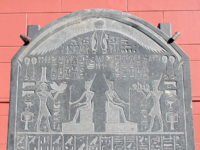
Twin steles of Decree of Nectanebo I
Encyclopedia

Nectanebo I
Nectanabo was a pharaoh of the Thirtieth dynasty of Egypt.In 380 BC, Nectanebo deposed and killed Nefaarud II, starting the last dynasty of Egyptian kings. He seems to have spent much of his reign defending his kingdom from Persian reconquest with the occasional help of troops from Athens or Sparta...
to be used on the Canopic branch
Canopus, Egypt
Canopus was an Ancient Egyptian coastal town, located in the Nile Delta. Its site is in the eastern outskirts of modern-day Alexandria, around 25 kilometres from the centre of that city....
of the Nile River, in the eastern Nile Delta
Nile Delta
The Nile Delta is the delta formed in Northern Egypt where the Nile River spreads out and drains into the Mediterranean Sea. It is one of the world's largest river deltas—from Alexandria in the west to Port Said in the east, it covers some 240 km of Mediterranean coastline—and is a rich...
of Lower Egypt
Lower Egypt
Lower Egypt is the northern-most section of Egypt. It refers to the fertile Nile Delta region, which stretches from the area between El-Aiyat and Zawyet Dahshur, south of modern-day Cairo, and the Mediterranean Sea....
. The steles were erected at two locations as statements to curry political favor with the priesthood, and possibly the populace.
The twin steles are identical in 14 columns of hieroglyphs except in column 13, where the stele's location is named. The stelae were erected shortly after Nectanebo came to power, ca 380 BC.
Stele description
The stele's purpose was to use a portion-(10 percent) of the water-way use tax, (import tax) for the services of the priests in charge of the temples of Goddess NeithNeith
In Egyptian mythology, Neith was an early goddess in the Egyptian pantheon. She was the patron deity of Sais, where her cult was centered in the Western Nile Delta of Egypt and attested as early as the First Dynasty...
.
A finely engraved lunette adorns the upper third of the steles; the engravings and hieroglyphs are all incised in moderate sunken bas relief. The lunette focusses on two versions of the Goddess Neith, being offered a food offering on the right, and a usekh collar
Usekh collar
The Usekh is a personal ornament, a type of collar or necklace, familiar to many because of its presence in widely-disseminated depictions of ancient Egyptian nobility, such as Tutankhamun, where an example can be seen on the famous gold mask....
on the left, by the presenter Nectanebo.
History of the steles
The first steleStele
A stele , also stela , is a stone or wooden slab, generally taller than it is wide, erected for funerals or commemorative purposes, most usually decorated with the names and titles of the deceased or living — inscribed, carved in relief , or painted onto the slab...
, the Stele of Naukratis was uncovered at Naukratis in 1899, and was subsequently translated.
Only recently its twin stele was recovered from the underwater site, associated with the town associated with Heracles
Heracles
Heracles ,born Alcaeus or Alcides , was a divine hero in Greek mythology, the son of Zeus and Alcmene, foster son of Amphitryon and great-grandson of Perseus...
, Heracleion also on the Canopic branch of the Nile.

